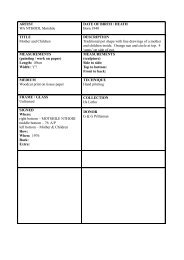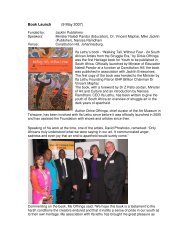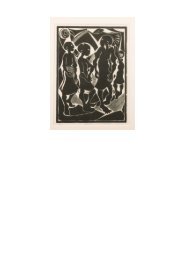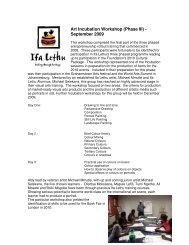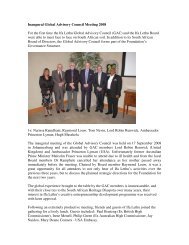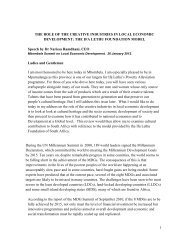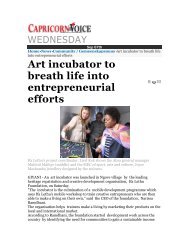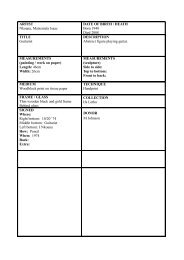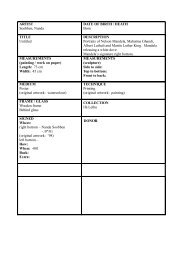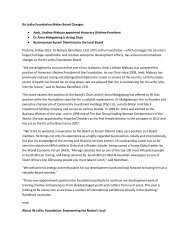Exiles' Return - Ifa Lethu
Exiles' Return - Ifa Lethu
Exiles' Return - Ifa Lethu
You also want an ePaper? Increase the reach of your titles
YUMPU automatically turns print PDFs into web optimized ePapers that Google loves.
SCUTH AFRICA RXP&KY<br />
EXILES' RETURN<br />
Spurred by a donation fronn a fcrrner Australian diplornat and ccllectcr,<br />
the lfa tethu Foundation today strives to repatrrate<br />
"struggle-era"<br />
works<br />
by Scuth Africa's largely self-taught black artists<br />
EY STEVEN O DUEIN<br />
SOUTH AFRICA UNDER aoartheid was<br />
a place of secrets, lies, disinformation,<br />
cover-ups and censorship-along with<br />
pervasive physical and psychological<br />
trauma. But the establishment of democracy<br />
in 1994 has spawned the desire for<br />
healing, as well as attempts to recover<br />
whatever has been lost, be it tangible<br />
or intangible. On the artistic front, this<br />
means recuperating the visual landscape<br />
of that period-most notably, the work of<br />
black artists who by and large were<br />
shunned by local white audiences and<br />
institutions. The recovery initiative aims<br />
to enlarge our understanding of contemporaneous<br />
creative expressions, credit<br />
people whose accomplishments have<br />
been overlooked and establish a legacy<br />
for future generations (the so-called<br />
"born-frees").<br />
lt is a daunting task. But<br />
history is being rewritten in part through<br />
efforts by the lfa <strong>Lethu</strong> ("Our Heritage")<br />
Foundation. which reoatriates art taken<br />
out of the country by diplomats, journalists<br />
and other foreigners during the<br />
1970s and '80s. Behind this undertaking<br />
lies a tale of past intrigue and<br />
present-day generosity.<br />
The story goes back to a cheeky<br />
23-year-old Australian on her first diplomatic<br />
posting, to Pretoria, in 1974.<br />
Diane Johnstone, while still a student,<br />
had demonstrated against a tour of<br />
the all-white South African Springboks<br />
rugby team to her country in 1971. To<br />
her horror, she arrived in South Africa<br />
at a time when it was not unusual to<br />
see police beat black people mercilessly<br />
in the streets. One of Johnstone's<br />
primary duties as Third Secretary was<br />
to supply political reportage, which<br />
could directly impact her government's<br />
policy-making. But the black townships<br />
were essentially off-limits to whites.<br />
The arts became her point of entry.<br />
Johnstone was befriended by two<br />
American diplomats, Jock Covey and<br />
Frank Strovas, who had established their<br />
bona fides among local black activists<br />
by organizing multiracial jazz sessions.<br />
Many of the musicians were visual artists<br />
as well-musical themes are commonplace<br />
in the works produced then-and<br />
only six months into her assignment<br />
Johnstone organized an exhibition<br />
shown over a weekend in her apartment.<br />
Pretoria's neighborhood of Sunnyside<br />
was then a white Afrikaner stronghold.<br />
Diane Johnstone with artist<br />
Michael Mmutle at the lfa <strong>Lethu</strong><br />
Foundat on, Photo Carolyn Schoeman<br />
CURRENTLY ON VIEW<br />
"Home and Away: A <strong>Return</strong> to the<br />
South" at the lziko O d Town House,<br />
Greenmarket Square, Cape Town,<br />
through Jan.25,2011.<br />
NOVEI,4BER']O ART IN ANIER]CA 69



